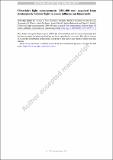Ultraviolet light measurements (280–400 nm) acquired from stratospheric balloon flight to assess influence on bioaerosols
Author(s)
Caro, Tristan A; Wendeln, Matthew; Freeland, Matthew; Bryan, Noelle; Waters, Samantha M; McIntyre, Alexa; Nicoll, Patrick; Madronich, Sasha; Smith, David J; ... Show more Show less
Download10453_2019_9597_ReferencePDF.pdf (774.8Kb)
Publisher Policy
Publisher Policy
Article is made available in accordance with the publisher's policy and may be subject to US copyright law. Please refer to the publisher's site for terms of use.
Terms of use
Metadata
Show full item recordAbstract
Abstract
Viable microorganisms collected from the Earth’s upper atmosphere are mysterious considering the intensely biocidal ultraviolet (UV) light conditions dominating rarefied air. Historically, most investigations examining the relationship between bioaerosols and UV conditions in the upper atmosphere have relied upon model-generated data. To address the shortage of in situ UV measurements in the upper troposphere and lower/middle stratosphere, we flew a meteorological balloon equipped with a UV radiometer and other core environmental sensors. The balloon payload launched from Illinois, USA, on October 6, 2018, and acquired UVA (315–400 nm) + UVB (280–315 nm) measurements for ~ 2 h up to 30.9 km. Above the atmospheric boundary layer, UVA + UVB values registered around 6 mW cm−2, results that were largely consistent with Tropospheric Ultraviolet–Visible model predictions. Performed in a low-cost, reusable manner with commercially available instruments, we show that reliable UV flux data can be acquired with meteorological balloon payload systems. This short communication provides relevant UVA + UVB results for aerobiology and astrobiology studies evaluating the survivability of microorganisms in the upper atmosphere.
Date issued
2019-06-24Department
Massachusetts Institute of Technology. Department of Earth, Atmospheric, and Planetary SciencesPublisher
Springer Netherlands